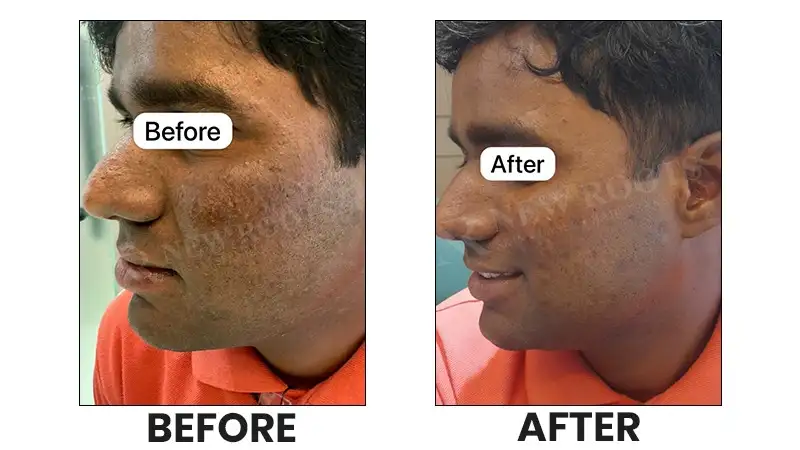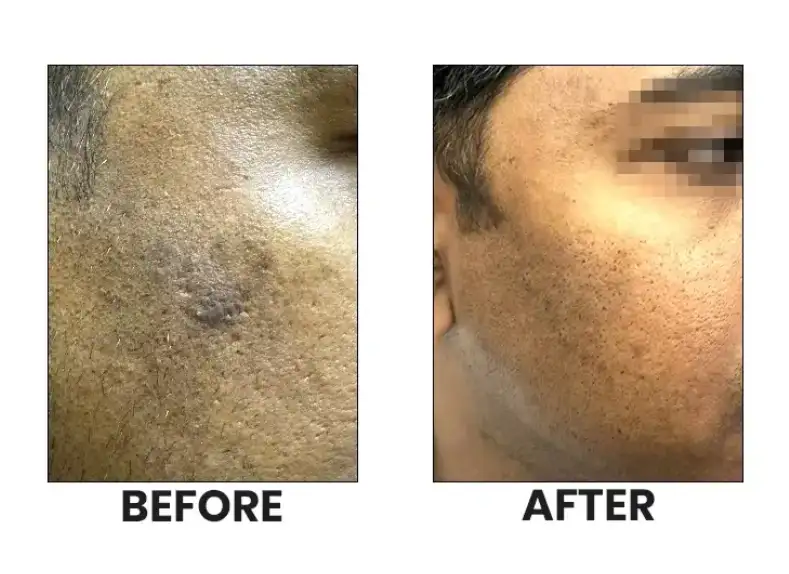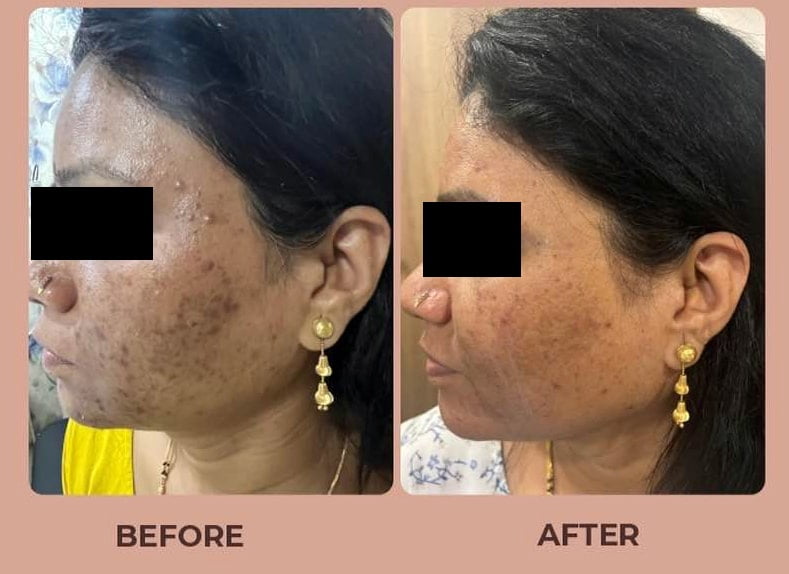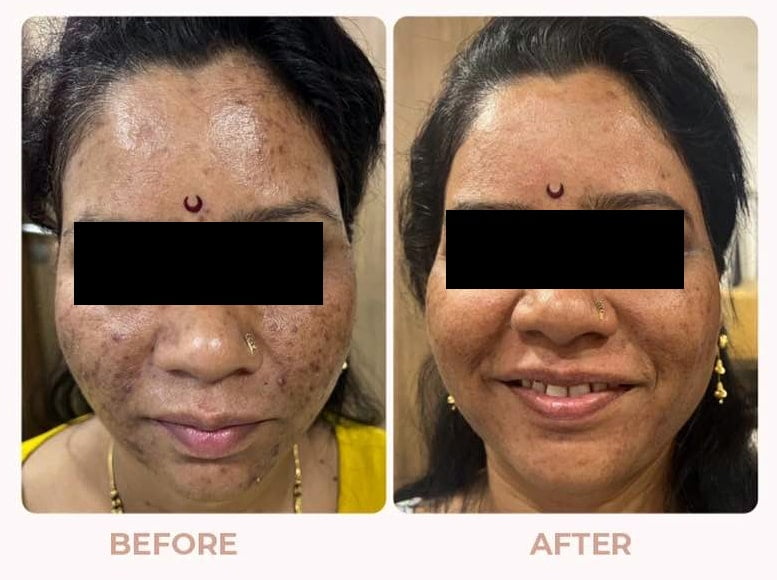

Laser Treatment for Pigmentation: Achieve Even-Toned and Radiant Skin!
OVERVIEW
Skin pigmentation refers to color of your skin. The amount and type of pigment called melanin reflects it. Changes in amount of pigment production leads to skin pigment disorders. Dark spots are reflected as hyperpigmentation, lighter spots are reflected as hypopigmentation. This eventually affects the color of our skin leading to uneven skin tone. Rather than trying OTC products and home remedies right time approach to dermatologist can resolve the issue soon.
TYPES OF PIGMENTATION
- 1. Hypopigmentation

Albinism
Albinism is best known for extremely pale skin that may have little to no color. This genetic condition can also make your hair white and your eyes light blue in color. People with albinism are born with this condition because of a genetic mutation.

Vitiligo
As Like albinism, vitiligo is characterized by lighter skin. However, this occurs in patches that cover your skin, rather than a widespread lack of color.

Pityriasis alba
Pityriasis alba refers to leftover white spots from previous cases of red, scaly skin patches.

Tinea versicolor
Tinea (pityriasis) versicolor comes from a fungal infection that occurs from overactive yeast on the skin.

Lichen sclerosus
Lichen sclerosus causes white patches that may eventually enlarge, bleed, and scar. These patches occur in the anal and genital areas. They can also develop on the breasts, arms, and upper body.
- 2. Hyperpigmentation

Age spots
This are brown, tan, or black spots that appear on the skin with sun overexposure. Commonly seen on sun exposed parts of body

Melasma
This are large patches of darkened skin often on the forehead, face, and stomach. Found usually in women who are pregnant or taking birth control pills.

Post inflammatory hyperpigmentation
This are spots or patches of darkened skin that appear after an inflammatory skin condition, such as acne or eczema.
SYMPTOMS OF PIGMENTATION
- Tanning of skin: Darkening of skin
- Freckles: Tiny dark skin spots
- Dark spots: Dark colored spots which distinguish from surrounding skin
- Focal pigments: Dark patches on face, forehead, neck, cheeks, etc.
CAUSES OF SKIN PIGMENTATION
- Causes of hypopigmentation
Atopic dermatitis
Also known as eczema, this skin condition causes red patches that are extremely itchy. As the skin heals, the patches may turn white.
Contact dermatitis
Touching chemicals may lead to this type of eczema and may cause lightened skin.
Healed blisters
As blisters heal, the affected skin flattens and may turn darker or lighter in color.
Infections of the skin
As your skin heals, lighter pigments may appear in areas affected by the infection.
Psoriasis
This autoimmune disorder causes your skin to produce new cells at an accelerated rate. Resulting silver and red patches may eventually heal and look lighter than the rest of your skin.
Scars and burns
These can lead to scar tissue that’s lighter than the surrounding skin.
- Causes of hyperpigmentation
Sun exposure
Sun triggers excess of melanin production and continuous exposure leads to hyperpigmentation.
Skin inflammation
Injury to dermis or epidermis due to acne or injury due to accidents stimulates melanocytes to produce excess of melanin and resulting in hyperpigmentation.
Hormonal imbalance
Hormonal imbalance leads to excess of progesterone or estrogen leading to excess of melanin.
Drug reaction
Drug hypersensitivity like NSAIDS, tetracycline, antimalarial leads to excess of melanin production.
Focal hyperpigmentation
Typically post inflammatory to conditions like phtophotodermatitits, acanthosis nigricans, lentigines.
Diffuse hyperpigmentation
conditions like Diffuse hyperpigmentation results from drugs as well as neoplastic causes like melanoma and lung carcinoma. Hemochromatosis, primary biliary cholangitis and Addison’s disease are a few medical conditions that are significant causes of hyperpigmentation.
HOW TO PREVENT HYPERPIGMENTATION
- By protecting the skin from the sun by using a sunscreen or using protection like clothes or umbrella.
- Avoiding picking off scabs of the skin after an injury or when there are spots, scabs, or acne
- Seeking professional advice before using creams to lighten dark patches, as this can cause reactions
TREATMENTS FOR SKIN PIGMENTATION
Topical treatments like creams and lotion which contains any of components can be used as per condition like azelaic acid, vitamin c, hydroquinone, corticosteroids, kojic acid, retinoids, arbutin,etc. selection of agents depends upon cause, depth, skin type, lifestyle of a person.
SKIN PIGMENTATION TREATMENT COST
The chemical peel treatments cost depends upon the type of peel may be superficial or deep used. It varies by number of sessions required and per session may cost from Rs.3000/- Rs.10000/-. NDYAG laser cost also varies upon the area of skin required and number of sessions required. Each session may cost upto Rs.5000/-to Rs.30000/-. laser treatments are usually combined with other therapies to enhance results.
WHY NEW ROOTS FOR SKIN PIGMENTATION
New roots provide multiple option interface so that fits patients suitably
New roots use high end UD FDA approved technology. Q- Switched Nd:YAG laser known by name tri – beam premium is used in new roots which is most advanced with effective features to achieve ideal results. This advanced technology provides safe and painless procedure along with 100 % efficacy. Our experienced dermatologists make sure that each patient is ensure with results. Our skin pigmentation treatments are designed to not only remove skin pigmentation but also, we make ensure that it rejuvenates your skin.
FAQ'S
Darker areas on the skin or due to excess production of melanin. Several conditions alter production of melanin like medications, pregnancy, endocrine disease, sun exposure,etc.
Use sunscreen with SPF, 30 or higher, protect your skin from sun, one can use home-made face pack prepared with curd mixed with haldi or curd mixed with gram flour, using deep pore cleansing milk twice a week.
Dark chocolates which contains more than 75% coco, are good antioxidants and stops skin ageing. Bell peppers are rich in vitamin C , vitamin B6 , Vitamin B9 & Also increases collagen production, sweet potato is a good source of beta-carotene.
Tomato and Green tea due to its antioxidant nature helps reduce inflammation in skin. Sunflower seeds contains vitamin E and zinc along with healthy fats, walnuts contains essential fatty acids protects skin from wrinkles and infection. Avoid dairy, fried, carbonated drinks and sugar products.
Three Things are important in reducing hyper pigmentation on face. First, one is regular sunscreen application containing SPF 30 + & PA +++ , second one is chemical exfoliation cream like glycolic, mandalic or salicylic acid cream & third is deep pigmenting creams, containing vitamin C, Kojic acid, azelaic acid, arbutin.
Avoiding Dairy products, SweetS, caffeine, fried food helps to reduce effects of sensitive skin.
Dermatologist will suggest according to the skin type which laser treatment is best. It uses targeted beams of light to reduce hyper pigmentation and improves the overall skin tone. now a days laser toning , carbon laser peel are in trends.




